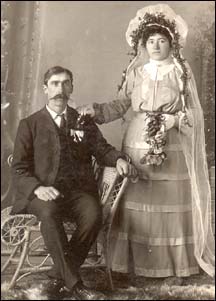
The author, Connie Williams, is doing graduate work in history at St. Cloud State University and has worked at the Paynesville Area Museum for several summers.
 |
(Editor's note: For the next year, we will present a series of articles that examine the years around 1900. Our purpose is to provide a comparison of the beginning of the 20th Century to its upcoming end. The author, Connie Williams, is doing graduate work in history at St. Cloud State University and has worked at the Paynesville Area Museum for several summers.
|
 "Something old, something new, something borrowed, something blue."
"Something old, something new, something borrowed, something blue."
Brides since the beginning of the 20th century have been following these words of wisdom, with some differences.
The wedding photograph of Mr.and Mrs. Ed Lemke. He wore a suit while she has a homemade dress and a very elaborate veil.
In the early 1900s, there were no bridal shops to buy wedding dresses. A seamstress, the mother of the bride, or a close relative made the bride's dress. Though sources say white was a popular color then, many of the pictures of area brides around the turn of the century show brides in darker colored dresses, such as gray and brown. This was probably a practical choice as brides could then wear the dress again.
An article from the Miami Times-Herald stated, "The bride was advised to choose colors and materials for her attendants' gowns that would be 'useful to the wearers after the wedding.'"
The price of a wedding has most certainly changed. An elaborate, long sleeved, beaded gown dress bought from the Sears-Roebuck catalogue in 1899 would cost around $25.
At the turn of the century, grooms usually wore a suit or, until about 1911, a Prince Albert coat which was a long, double-breasted frock coat.
Wedding ceremonies
While most weddings today are held on a weekend, many weddings used to be held on a weekday. Tuesdays, Wednes-days, and Thursdays were the most popular choices.
"Invitations are being issued this week for the wedding of Miss Ivy Tuttle to Mr. John Hoel, which will occur at the home of the bride's parents in this city on next Wednesday evening at six o'clock," read an announcement from the front page of the April 20, 1899, New Paynesville Press. "The wedding will be a private affair and only near relatives and a few intimate friends will be present."
Two things about that announcement catches one's eye besides the fact it was held on a Wednesday. First, the invitations were being sent only a few days before the wedding. Invitations in 1900 were often hand-written and sent by messenger.
The other is the place. Many turn of the century weddings were held at the home of the bride or a close relative, or at the parsonage of the minister. They were held only occasionally in a church.
"The marriage of John Jacobs and Miss Margaret Backes occurred in the church of St. Peter and Paul Monday morning at nine o'clock before a large number of invited guests," said the story in the New Paynesville Press April 20, 1899. "A wedding reception was given at the home of the bride's father after the ceremony."
Today most receptions are held in a public place, either a restaurant, night club, banquet hall, or church fellowship hall. At the turn of the century, a reception was likely held in the bride's home, where the family cooked the food themselves.
Photographs in 1900 were usually formal portraits of just the bride and groom and were almost always taken in a studio. In the middle of the century, photographs were taken after the wedding. A session often lasted up to two hours while the guests waited at the reception. Today photographers take pictures before, during, and after the wedding.
The groom and his family had it easier financially at the turn of the century. Their only expenses were the ring and clergyman's fees. Now families often split expenses for a wedding.
Tidbits
In 1899, there was no such thing as a gift registry. Gifts, if given, were decorative pieces, such as sugar bowls or candy dishes. It wasn't until 1914 that store owners began to make notes of items bridal couples liked.
Announcements in the newspaper at the turn of the century had more editorial liberty than today. The story about the wedding of A.B. Phillips to Miss Edith Chisholm in the New Paynesville Press on Oct. 12, 1899, included such words. "Both the bride and the groom are too well-known in this community to need any eulogizing comments in these columns. They are very prominent young people and represent two of the oldest families in New Paynesville. The Press heartily joins with their many friends in wishing them joy and prosperity in their happy union. We truly hope their cup of happiness will overflow."
Elopements happened and were even reported in print at the turn of the century as well. An account from the Nov. 2, 1899, New Paynesville Press reads: "Phil Henk attempted to steal a march on his friends Tuesday and gave it out that he was going to drive to Litchfield, but instead he drove to St. Cloud, accompanied by Miss Clara Woodhouse, where they were joined in the holy bonds of matrimony. The ruse was discovered, however, and when the happy couple returned the entire city was ready to congratulate and welcome them."
Remembrances
Bertha Zniewski's parents, Dahlia Lewerenz and Aguar Robin, were married on a family farm in North Town on July 1, 1919. Their wedding was held at home with a barn dance following. The family even served liquor.
When Bertha married Frederic Zniewski on Jan. 13, 1946, Frederic had only been home from the service since Christmas Eve. Bertha's attendants used dresses from the wedding of her roommate who had been married the month before.
When Rev. Lynn Luthard, who served Nordland and Zion Lutheran churches from 1967 to 1974, started his ministry in 1939 in North Dakota, he had very few church weddings. By far, the majority of the weddings Luthard performed were in homes. In a four-point parish in North Dakota, Luthard's predecessor had the first church wedding. Luthard had the first wedding in two of the churches and his successor had the first wedding in the fourth.
Once in awhile a couple would come to the parsonage to be married. The bride usually would have a bouquet of flowers, a witness each, and that was all. The bride usually wore a dress and the groom a suit. Nothing was fancy, Luthard said
One of the first weddings he had in his first parish was a couple who married in the home of a neighbor of the bride's. Some of the men loaded up the little reed organ from the church and hauled it to the home. During the middle of the ceremony, a rather bold mouse hopped out of the organ. Everyone started giggling. Rev. Luthard, who hadn't seen the mouse and didn't know what was going on, didn't find the giggling amusing. "I was very young and serious," he said. He learned about the mouse later on.
Father Leo Leisen, who serves the parishes in Roscoe, Lake Henry, and Spring Hill, remembers that mass servers after WWII had a game where they would beat the couple out of the church. They, in fun, wouldn't allow the couple out of the church until the servers were paid for their services. Fifty cents was a lot to receive. The money was combined and later used for a picnic.
One wedding that stands out in Leisen's memory was the wedding of his cousin. People were supposed to fast for hours before communion. During the wedding, the bride keeled right over, apparently from hunger. Any Catholic who remembers those days can relate.
Attitudes in the Catholic church have changed a lot in recent years, said Leisen. Years ago, the wedding had to be in the church of the bride. Now they can be in the church of either the bride or the groom. Now most Catholic priests will team up with other pastors for an ecumenical wedding, Leisen added.
A near miss
Rosemary Zapf first met her future husband, Milt Koshiol, when she was in fourth grade and he was in sixth grade. Milt lived down the street from her aunt and uncle in St. Cloud.
Rosemary and Milt got married on a beautiful fall day, Oct. 6, 1947, at St. Louis Catholic Church in Paynesville with Father Joseph Varley presiding. Milt had to borrow a buddy's car to come from St. Cloud where he lived to his wedding in Paynesville.
On the way, the car broke down, and Koshiol had to hitchhike. He was picked up by Rosemary's uncle. However, by the time he got to church, everyone was walking up the front steps! "I didn't know all of this or I'd have had a heart attack," Rosemary related.
In addition, Milt had to borrow another car to go to Bemidji for the honeymoon.
They didn't have a professional photographer because they would have had to go to St. Cloud. Instead they had a friend, Bill Henderson, take pictures. There weren't very good flash cameras in those days so most of the pictures were taken outside. Father Varley was quite a photographer and he even borrowed a camera from the Paynesville Press to take pictures at the wedding.
They had a chicken dinner at the church after the wedding. The women of the parish helped. Rosemary's waitresses were former choir members. Her mother, who had made all the bridesmaid's dresses, also made aprons for all the waitresses. There was enough food left over that it was announced that the people could come back for supper.
In addition to the church dinner, there was a reception at Rosemary's mother's house. Neighbors helped prepare sandwiches and other goodies.
(The July Turn of the Century column will be about 4th of July celebrations.)